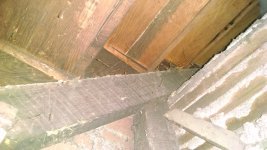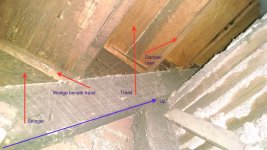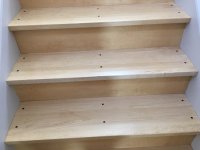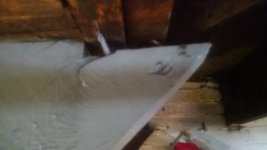All,
In a prior thread, I had brought up a question around repairing my staircase : link
With the long weekend coming up, I was once again considering making this repair.
My staircase is a combination of house stringer on one side and open/closed on the other. The risers in the open part are mitered to the open stringer.
From what I can see, it looks as if the riser also is dadoed to receive the tread.
I'm not really able to access the back of the staircase from below, as it is plastered and painted with ~85 years of paint and other parts of the house have known asbestos in the plaster.
What I'm thinking about doing is bolstering the existing stringers with either 2x material or laminated plywood to create a broader bearing area for the treads to rest upon. Perhaps also filling the housed stringer mortises to level with the other stringers.
I'm thinking that I can attach to the bolsters with structural screws and ample adhesive. Then I will attach the treads using more adhesive and trim head screws.
I'll be using pine treads, which will be finished using a combination of dye, gel stain, and varnish.
Below is a photo of what I can see from the basement.
View attachment 1
Admittedly, this isn't the most optimal approach, but I'm not certain that there is even sufficient room to reseat wedges given the 2x that is below the stringer.
Do folks think this approach would be successful? If so, would I be better served using plywood or 2x material? Any other ideas?
Thanks,
Adam
In a prior thread, I had brought up a question around repairing my staircase : link
With the long weekend coming up, I was once again considering making this repair.
My staircase is a combination of house stringer on one side and open/closed on the other. The risers in the open part are mitered to the open stringer.
From what I can see, it looks as if the riser also is dadoed to receive the tread.
I'm not really able to access the back of the staircase from below, as it is plastered and painted with ~85 years of paint and other parts of the house have known asbestos in the plaster.
What I'm thinking about doing is bolstering the existing stringers with either 2x material or laminated plywood to create a broader bearing area for the treads to rest upon. Perhaps also filling the housed stringer mortises to level with the other stringers.
I'm thinking that I can attach to the bolsters with structural screws and ample adhesive. Then I will attach the treads using more adhesive and trim head screws.
I'll be using pine treads, which will be finished using a combination of dye, gel stain, and varnish.
Below is a photo of what I can see from the basement.
View attachment 1
Admittedly, this isn't the most optimal approach, but I'm not certain that there is even sufficient room to reseat wedges given the 2x that is below the stringer.
Do folks think this approach would be successful? If so, would I be better served using plywood or 2x material? Any other ideas?
Thanks,
Adam





